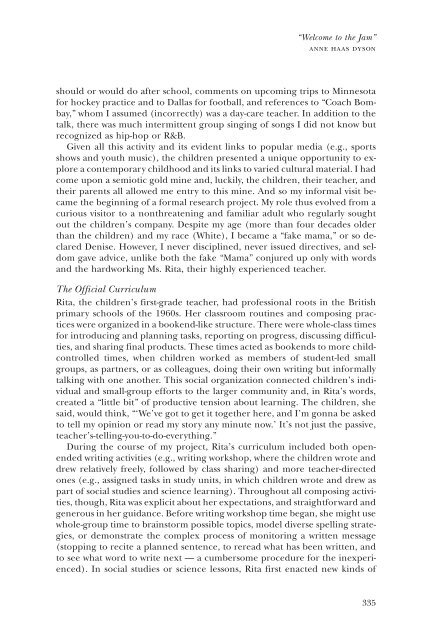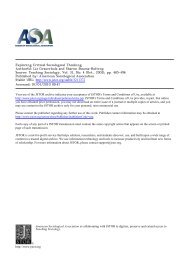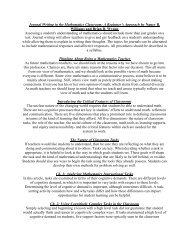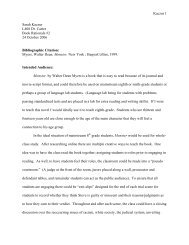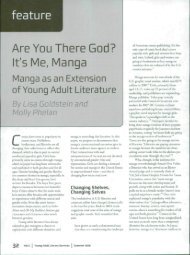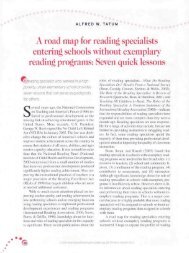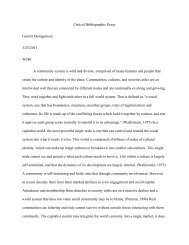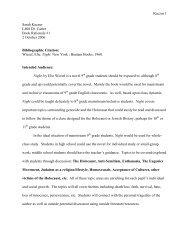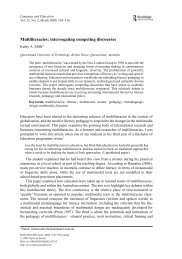Dyson 2003 Welcome to the Jam.pdf - Oncourse
Dyson 2003 Welcome to the Jam.pdf - Oncourse
Dyson 2003 Welcome to the Jam.pdf - Oncourse
Create successful ePaper yourself
Turn your PDF publications into a flip-book with our unique Google optimized e-Paper software.
“<strong>Welcome</strong> <strong>to</strong> <strong>the</strong> <strong>Jam</strong>”<br />
anne haas dyson<br />
should or would do after school, comments on upcoming trips <strong>to</strong> Minnesota<br />
for hockey practice and <strong>to</strong> Dallas for football, and references <strong>to</strong> “Coach Bombay,”<br />
whom I assumed (incorrectly) was a day-care teacher. In addition <strong>to</strong> <strong>the</strong><br />
talk, <strong>the</strong>re was much intermittent group singing of songs I did not know but<br />
recognized as hip-hop or R&B.<br />
Given all this activity and its evident links <strong>to</strong> popular media (e.g., sports<br />
shows and youth music), <strong>the</strong> children presented a unique opportunity <strong>to</strong> explore<br />
a contemporary childhood and its links <strong>to</strong> varied cultural material. I had<br />
come upon a semiotic gold mine and, luckily, <strong>the</strong> children, <strong>the</strong>ir teacher, and<br />
<strong>the</strong>ir parents all allowed me entry <strong>to</strong> this mine. And so my informal visit became<br />
<strong>the</strong> beginning of a formal research project. My role thus evolved from a<br />
curious visi<strong>to</strong>r <strong>to</strong> a nonthreatening and familiar adult who regularly sought<br />
out <strong>the</strong> children’s company. Despite my age (more than four decades older<br />
than <strong>the</strong> children) and my race (White), I became a “fake mama,” or so declared<br />
Denise. However, I never disciplined, never issued directives, and seldom<br />
gave advice, unlike both <strong>the</strong> fake “Mama” conjured up only with words<br />
and <strong>the</strong> hardworking Ms. Rita, <strong>the</strong>ir highly experienced teacher.<br />
The Official Curriculum<br />
Rita, <strong>the</strong> children’s first-grade teacher, had professional roots in <strong>the</strong> British<br />
primary schools of <strong>the</strong> 1960s. Her classroom routines and composing practices<br />
were organized in a bookend-like structure. There were whole-class times<br />
for introducing and planning tasks, reporting on progress, discussing difficulties,<br />
and sharing final products. These times acted as bookends <strong>to</strong> more childcontrolled<br />
times, when children worked as members of student-led small<br />
groups, as partners, or as colleagues, doing <strong>the</strong>ir own writing but informally<br />
talking with one ano<strong>the</strong>r. This social organization connected children’s individual<br />
and small-group efforts <strong>to</strong> <strong>the</strong> larger community and, in Rita’s words,<br />
created a “little bit” of productive tension about learning. The children, she<br />
said, would think, “‘We’ve got <strong>to</strong> get it <strong>to</strong>ge<strong>the</strong>r here, and I’m gonna be asked<br />
<strong>to</strong> tell my opinion or read my s<strong>to</strong>ry any minute now.’ It’s not just <strong>the</strong> passive,<br />
teacher’s-telling-you-<strong>to</strong>-do-everything.”<br />
During <strong>the</strong> course of my project, Rita’s curriculum included both openended<br />
writing activities (e.g., writing workshop, where <strong>the</strong> children wrote and<br />
drew relatively freely, followed by class sharing) and more teacher-directed<br />
ones (e.g., assigned tasks in study units, in which children wrote and drew as<br />
part of social studies and science learning). Throughout all composing activities,<br />
though, Rita was explicit about her expectations, and straightforward and<br />
generous in her guidance. Before writing workshop time began, she might use<br />
whole-group time <strong>to</strong> brains<strong>to</strong>rm possible <strong>to</strong>pics, model diverse spelling strategies,<br />
or demonstrate <strong>the</strong> complex process of moni<strong>to</strong>ring a written message<br />
(s<strong>to</strong>pping <strong>to</strong> recite a planned sentence, <strong>to</strong> reread what has been written, and<br />
<strong>to</strong> see what word <strong>to</strong> write next — a cumbersome procedure for <strong>the</strong> inexperienced).<br />
In social studies or science lessons, Rita first enacted new kinds of<br />
335


